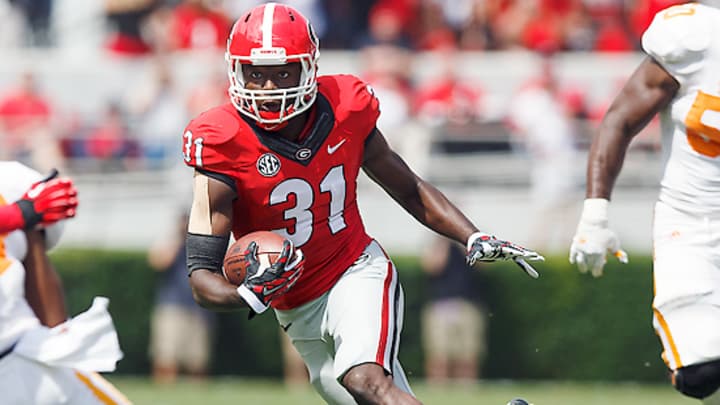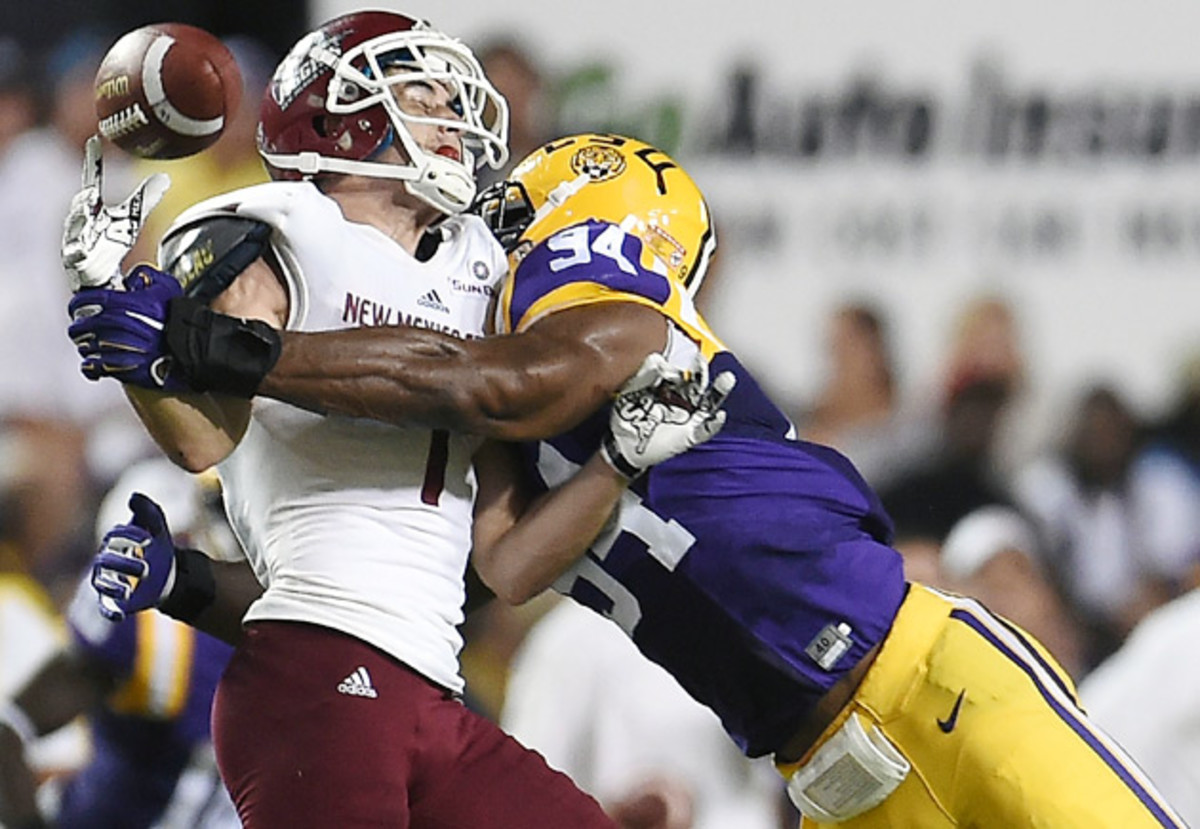Five 2015 draft prospects who could be better in NFL than in college

Sometimes it’s easy to tell from a player’s college football career that he’ll provide great value in the NFL. Those of us who follow the college game love to say “I told you so” with regard to players such as Chris Borland. Borland was a football-seeking missile of at Wisconsin. Sure, he was undersized. But he also was a linebacker who occasionally returned kickoffs and punts in the Big Ten. On-field production + Unusual athleticism = Likely NFL success. And when Patrick Willis went down for the 49ers last year, third-round pick Borland filled in for perhaps the game’s best inside linebacker and racked up 107 tackles in 14 games.
Borland’s success was simple to predict. But how do we college football aficionados explain Seantrel Henderson? The former top recruit couldn’t hold down a starting job at Miami. He looked sluggish in Senior Bowl practices. He stopped his Pro Day workout before finishing drills because of dehydration. Then the 6’7”, 331-pounder got drafted in the seventh round and started all 16 games for the Bills at right tackle. Against better competition in a more cutthroat setting, Henderson succeeded. And he’s not alone.
• 2015 NFL Mock Draft: Jameis No. 1 | All-Combine Team: Who impressed?
The NFL is full of players who have performed better at the highest level than they did against lesser competition in college. Defensive tackle Dontari Poe couldn’t crack the All-Conference USA first team at Memphis, yet he made the 2015 Pro Bowl for the Chiefs. Ja’Wuan James played right tackle while Tiny Richardson manned the left side for Tennessee, but James was the first-rounder who wound up sliding from right to left tackle as a Dolphins rookie.
There are plenty of reasons that average or pretty good college players become great NFL players. Maybe the guy had to play out of position in college to give his team the best chance to win. Maybe his college team ran a system that didn’t suit his strengths. Maybe, like Henderson, he simply needed to mature. Guessing which players will make this leap is a crapshoot of the highest order, but we’ll attempt to identify a few 2015 draft-eligible players who could—for a variety of reasons—outplay their college selves in a tougher league.
Anthony Chickillo, DE, Miami
This NFL Network interview with Chickillo from the East-West Shrine game drove home a lot of the criticisms of coordinator Mark D’Onofrio’s defense at Miami. Chickillo, playing in a one-gap, 4-3 scheme for the week of the all-star game, was explosive and relentless. When reporter Alex Flanagan asked Chickillo where he picked up such a quick “get-off,” Chickillo laughed. “I’ve always had it,” Chickillo said. “In college I was asked to two-gap. I’ve always had it, and I’m happy to use it out here today.”
2015 NFL draft Big Boards: Leonard Williams leads our dueling top 40s
Chickillo started all four years at Miami, and his sack total went down each season. As a senior, he made 41 tackles and 4.5 tackles for loss. Those aren’t unusual numbers for a 3-4 defensive end asked to occupy two gaps, and video shows Chickillo didn’t take plays off. In a 4-3 defense, the 6’4”, 282-pounder with a 4.79 40-yard dash and a 34.5-inch vertical jump would have had the power and size to set the edge and the speed to disrupt the opponents’ passing game. But getting pushed further inside and asked to occupy blockers to free up others to make plays didn’t suit Chickillo’s skill set as well. He simply was limited by the Hurricanes’ scheme.
The question is whether this was the best possible deployment of Miami’s talent. The Hurricanes finished 15th in the nation in yards allowed per play (4.79), which suggests the scheme was fairly effective. But Miami also finished with a 6-7 record, and that wasn’t entirely the offense’s fault. The Hurricanes’ defense ranked 97th in the nation in tackles for loss (4.92 a game). Negative plays can end drives quickly and help jump-start ensuing offensive possessions because of better field position. Perhaps using Chickillo in a different role—which is doable without altering too much as most teams show odd and even looks no matter their base defense—could have helped in that department. If Chickillo winds up playing as a 4-3 defensive end in the NFL, we’ll see if a change of role is all he needed to unlock his potential.
Chris Conley, WR, Georgia
Conley was a productive receiver at Georgia, but after a combine workout that got Lucas Oil Stadium buzzing, it’s worth asking why he wasn’t more productive. The 6’3”, 205-pound wide receiver ran a 4.35-second 40. His vertical jump was 45 inches—three inches more than any other receiver. His 11-foot, 7-inch broad jump was seven inches better than any other receiver.
There are two logical explanations for why Conley’s college career didn’t give him more draft buzz, and we won’t know which one is the correct one until he gets into a camp. The simplest is that the reigning SEC Scholar Athlete of the Year is a workout warrior. But a look at his Georgia career suggests that isn’t the case. The second is that Conley was limited by factors outside his control at Georgia. This seems more likely.
Conley first cracked the regular receiving rotation as a sophomore in 2012. But he was playing alongside Tavarres King, Malcolm Mitchell, Marlon Brown and tight end Arthur Lynch, so quarterback Aaron Murray had plenty of targets. Murray also had freshman tailbacks Todd Gurley and Keith Marshall, who combined to rush for 2,144 yards. This team came within a few yards of playing for the national title—and it would have crushed Notre Dame just like Alabama did—so it’s tough to quibble with the deployment of offensive weapons.
[daily_cut.NFL draft]
The 2013 season, Conley’s last with Murray, is when Conley should have broken out, but there are also very good reasons why that didn’t happen. Georgia started the season with a loaded receiving corps, and that group began to fall apart almost immediately. Mitchell was lost for the year in the season opener. Speedster Justin Scott-Wesley lasted about a month before he was lost for the season. Michael Bennett had to adjust gradually as he returned from an ACL injury the previous season. Conley was the team’s best receiver, but he sprained an ankle against Vanderbilt in mid-October, missed two games and wasn’t the same again. He still led Georgia in receiving with 651 yards, but a healthy season alongside some other healthy receivers—so he wouldn’t be bracketed by opponents—would have produced much better numbers.
In 2014, fifth-year senior Hutson Mason took over at quarterback. He was not Aaron Murray. Georgia’s best offensive option became handing off to Gurley, Nick Chubb and Sony Michel. Conley once again led the Bulldogs with 657 receiving yards, but he played on a team that averaged 42.6 rushes per game and 24.8 passes per game. Conley caught two passes for 45 yards for the winning team in the NFLPA Collegiate Bowl in January, and he said last week at the combine that his week of practice for the all-star game gave him a new perspective. “I learned I can compete with pretty much anyone,” Conley said. “At that game, you had people coming from across the country, people who were the best at their respective schools. It’s a time to see what peer competition was. I was able to build some confidence.”
Before this, Conley was probably best known for his performance in the classroom and for including Bulldogs coach Mark Richt in a laser battle in a scene from the Star Wars fan film Conley wrote and directed. Now, he’s known as the guy who tore up the combine. Whether he becomes known as a great NFL player is up to him.
Carl Davis, DT, Iowa
Two-gap defensive tackles are never going to post huge numbers, but Davis got knocked at Iowa for getting blocked too often. In Senior Bowl practices, some of the best offensive linemen in the country couldn’t block Davis at all. “I just wanted to go down there on a mission and show who I was and get my name back ringing a little bit,” Davis said last week.
His name is clanging now. The 6’5”, 320-pounder would have intrigued NFL personnel types with his 5.07-second 40 and 33-inch vertical jump, but add in that performance in actual football practices in pads against actual linemen, and Davis has probably made himself some money in the past two months. The question is whether he can duplicate the level of competitiveness he showed in Senior Bowl practices for all the years he hopes to play in the NFL.

Danielle Hunter, DE, LSU
He’s 6’5”. He weighs 252 pounds. He ran a 4.57-second 40 at the combine—fastest of any defensive lineman. So how in the world did Hunter have only 1.5 sacks last season? It could be because he didn’t fire off the ball as quickly as his fellow defensive linemen or because Hunter played tentatively rather than instinctively.
Learn The Names: The four faces of Washington's defense
But keep in mind that LSU’s defensive line in 2014 was not what we’ve grown accustomed to from the Tigers. In past years, LSU had four experienced swamp monsters up front with four future stars rotating in behind them. But that hasn’t really been the case since ‘11.
Despite this, Hunter still had 73 tackles with 13 for loss. So his production may have been a case of the best athlete trying to help make up for the deficiencies of the rest of the group. We’ll find out when Hunter starts facing NFL offensive linemen while playing alongside defensive linemen who are his athletic equals.
Darren Waller, WR, Georgia Tech
Waller played receiver in an option offense, so that goes a long way toward explaining why he had only 971 receiving yards in three seasons. Waller also spent some time in coach Paul Johnson’s doghouse, getting suspended for the 2013 season opener and the first two games of the ‘14 season.
When DeAndre Smelter missed the 2014 ACC championship game and the Orange Bowl and Waller had to be the Yellow Jackets’ top pass-catching threat, he came through. In those two games, Waller caught 10 passes for 187 yards and two touchdowns. (Georgia Tech attempted 26 total passes in those two games.)
Add those performances against two good defenses (Florida State and Mississippi State) to the measurables, and Waller suddenly becomes very interesting. He’s 6’6” and 238 pounds with a 4.46-second 40 and a 37-inch vertical jump.
Forget the comparisons to fellow former Yellow Jacket Demaryius Thomas—who signed to play in Chan Gailey’s pro-style offense and wound up playing two seasons in Johnson’s offense. Thomas ran five hundredths of a second faster at the combine, but he was three inches shorter and 15 pounds lighter. Waller is 22 pounds lighter than Jimmy Graham was when he came out of Miami, but Waller ran a tenth of a second faster than Graham at the combine.
Does that mean Waller will be as good as Graham? Absolutely not. It means he has similar tools and is about as raw as the four-year college basketball player Graham was when he reached the NFL. Waller will determine where the comparison goes from here.
